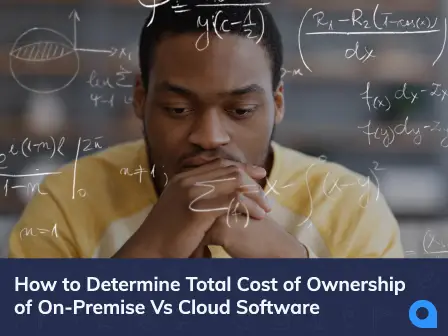
As you're evaluating potential new business software for your organization, inevitably, someone will bring up cost. Your purchasing department will likely want to know if moving to the cloud is cheaper than on-premise solutions, or vice versa. "Money doesn't grow on trees," they might remind you.
To truly compare cloud vs on-premise costs, you should first calculate the total cost of ownership or TCO. The TCO is a financial estimate created to help buyers and owners determine the direct and indirect lifetime costs of a product or service.
You can apply this concept to anything you're considering buying, from software to a car to a new puppy! Calculating the TCO takes into account purchase price, maintenance, and lifetime operational costs.
For example, the total cost of ownership for new software generally includes training fees, hardware, implementation, customization, and data migration, all on top of the up-front software purchase. If you want to accurately predict your future return on investment (ROI) for your new software, you need to understand the software's TCO first.
Essentially, TCO = Capital expenditures (CAPEX) + Operating expenditures (OPEX).
So, IS cloud cheaper than on-premise? Let's take a look at the cloud vs on-premise TCO so you can report back to the people holding the purse strings.

On-Premise TCO
Building a new garden shed from the ground up takes a lot more time and money than buying a prefab shed from Home Depot. Similarly, setting up an on-premise system for the first time takes effort, and can come at a high cost.To deploy an on-premise system, you'll need to make an initial investment into servers, infrastructure, and processes.
You're also responsible for the continued maintenance and ongoing operating costs as time goes by, so be sure to add those line items into the anticipated budget.
Lastly, the lifespan of physical equipment is about 3 – 5 years, meaning you'll need to add future equipment replacement into your TCO calculation.
As we said above, TCO = Capital expenditures + Operating expenditures. Here's a breakdown of those expenses when it comes to on-premise software solutions:
| Capital Expenditures: On-Premise | Operating Expenditures: On-Premise |
|---|---|
| • Server purchase | • Lifetime updates and improvements |
| • Storage fees | • Maintenance |
| • Security | • Technical support |
| • Network | • Staff training |
| • Internet (IP) | • Energy consumption |
| • Software licenses | • Temperature monitoring |
| • Infrastructure design | • End of life disposal |
| • Backup system | • Equipment replacement |
| • Datacenter location | |
| • Redundancy to 2 data centers (recommended for disaster recovery) | |
Cloud Cost TCO
Continuing our garden shed analogy, choosing a cloud software provider is kind of like living in a house that already had a shed when you bought it. You didn't need to go buy a prefab shed or a bunch of wood to build a shed because you already had one.
With a cloud solution, you don't need to make a lot of up-front expenditures on servers or renting space at a datacenter because it's all already there in the cloud! As such, cloud implementation is much cheaper and faster than setting up an on-premise system.
Moving to the cloud eliminates many ongoing operating costs, as well. Your company isn't paying for updates and maintenance or worrying about temperature monitoring; that's all performed by the cloud host. You also don't need to maintain your own security procedures, which can reduce your staffing needs.
Using cloud software won't eliminate all costs. Training will likely be required for any new solution, and your provider may charge for support when you have questions. Despite those costs, most organizations find that migrating to the cloud results in a significant TCO reduction.
Take the time to compare cloud vs on-premise total cost of ownership and you'll be well on your way to understanding which software solution is right for your organization.
And if you're still not sure after you've calculated the TCO of the tools you're considering, download our free ebook, On-Premise Vs Cloud Software: The 6 Step Executive Guide. In this ebook, we walk you through deployment speed, uptime, compliance, and more factors to consider.

 Ryan Muir
Ryan Muir